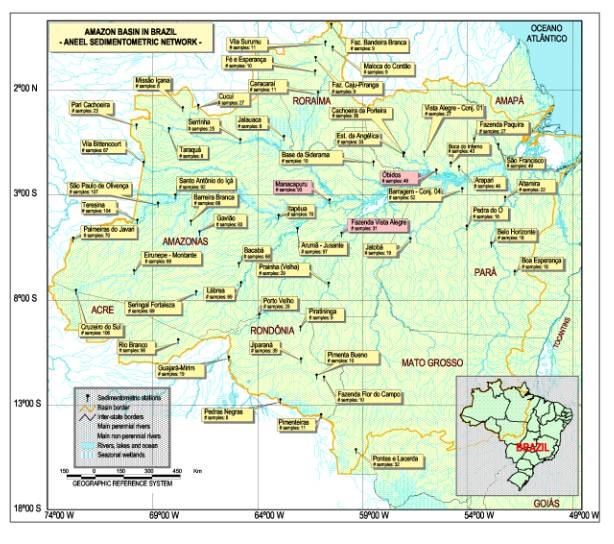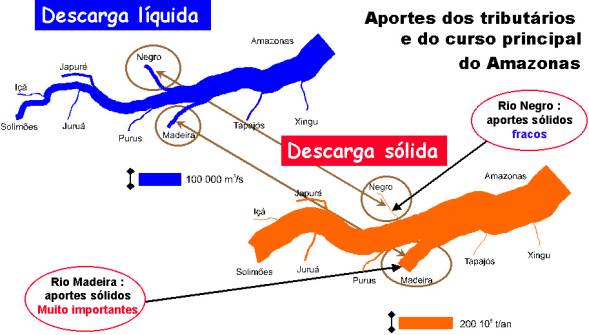UNIVERSIDADE DE BRASÍLIA - INSTITUTO DE GEOCIÊNCIAS
![]()
UNIVERSIDADE DE BRASÍLIA - INSTITUTO DE GEOCIÊNCIAS![]()
DISSERTAÇÃO DE MESTRADO No
122![]()
NAZIANO PANTOJA FILIZOLA JÚNIOR
FLUXO DE SEDIMENTO EM SUSPENSÃO NOS RIOS DA BACIA AMAZÔNICA BRASILEIRADATA DE DEFESA: 14/11/97
RESUMO
Dentro da atual discussão
relacionada às questões ambientais amazônicas, o fluxo do material em suspensão,
assim como o fluxo hídrico superficial, constituem ferramentas básicas para a
avaliação dos mais diversos parâmetros geoquímicos dessa que é a maior
bacia hidrográfica do planeta. Diversos experimentos têm realizado balanços
hidrossedimentológicos no Rio Amazonas e estimativas do fluxo de sedimentos em
suspensão na sua foz no Oceano Atlântico. Alguns, citam o Amazonas como o
maior rio do mundo em termos de fluxo de material em suspensão. Nesse estudo
faz-se uma avaliação do banco de dados do DNAEE, órgão do governo
brasileiro, que opera uma rede sedimentométrica, com 60 postos na região, há
mais de dez anos (fig.1). Esses dados, hoje sob a responsabilidade da Agência
Nacional de Energia Elétrica - ANEEL, com mais de 2500 amostragens já
realizadas, possibilitaram uma boa avaliação das questões relativas ao balanço
hidrossedimentológico. Tornaram viável realizar uma estimativa do fluxo de
material em suspensão na foz do Amazonas da ordem de 600 106 ton.ano-1,
o que posiciona o Amazonas como o terceiro maior do mundo nesse quesito (fig.2).
O Rio Solimões juntamente com o Rio Madeira são responsáveis por cerca de 95%
do transporte de material em suspensão na bacia. Reforçando, portanto o papel
dos rios de origem andina no processo que regula o transporte de sedimentos em
suspensão na Bacia Amazônica brasileira.

Fig.1_Rede Sedimentometrica do DNAEE, hoje sob responsabilidade da ANEEL.

Fig.2. Bacia Amazônica. 209.000m3.s-1 de descarga líquida anual média e cerca de 600.106 ton.dia-1 de aporte de sedimentos ao Oceano
![]()
UNIVERSITY OF BRASILIA- INSTITUTE OF GEOSCIENCES![]()
MSc THESIS No
122![]()
NAZIANO PANTOJA FILIZOLA JÚNIOR
FLOW OF SEDIMENTS IN SUSPENSION IN THE RIVERS OF THE BRAZILIAN AMAZONIC BASINDATE OF ORAL PRESENTATION: 14/11/97
ABSTRACT
In actual discussions involving Amazon environment, the suspended
sediments flux or discharge, as the water flow, are both, basic informations for
other scientific assessements, specially concerning geochemical flow. Some
experiments was done on suspended sediment budgets in Amazon basin and some
estimations of the suspended sediment flux at the mouth of the Amazon river, was
also made. As a conclusion scientists have citted the Amazon river as one of the
biggest rivers in the world on suspended solids discharge. Concerning this
theme, in this text, a study was done with DNAEE sedimentometric network, a
brasilian government agency that operates 60 stations, since 1977 (fig.1).. This
agency has done more than 2500 samples for TSS-total suspended solids. These
data and network are actually under the management of the Brazilian National
Agency for Electric Power – ANEEL and makes possible a good assessement of the
TSS transported by rivers on the Amazon basin. A new estimation, of about 600 106
t.ano-1, was done for the mean annual discharge of suspended
sediments at the mouth of the Amazon river (fig.2).. These results
re-classified, that big river, as the third one in the world, concerning the
sediment yield. The Solimões and Madeira, rivers ones that cames from the
Andes, are the greatest contributors in therms of suspended solids transport.
They represents 95% of all the TSS transported on the Amazon Basin. Also, these
results reinforce the importance of the Andes on the Amazon river basin system
of suspended sediments transport in Brazil.

Fig.1_Rede Sedimentometrica do DNAEE, hoje sob responsabilidade da ANEEL.

Fig.2. Bacia Amazônica. 209.000m3.s-1 de descarga líquida anual média e cerca de 600.106 ton.dia-1 de aporte de sedimentos ao Oceano